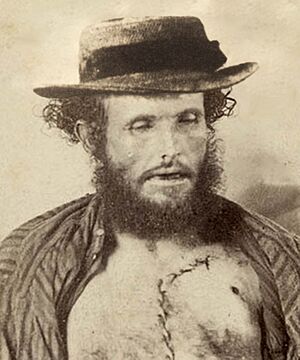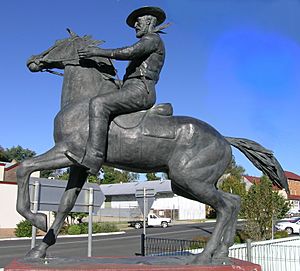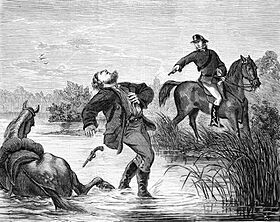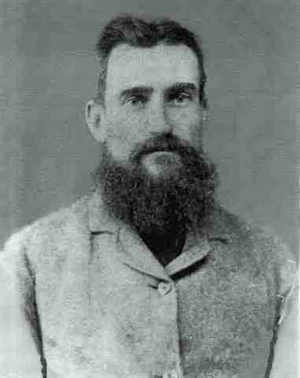Captain Thunderbolt facts for kids
Quick facts for kids
Captain Thunderbolt
|
|
|---|---|

Captain Thunderbolt after being shot in 1870
|
|
| Born |
Frederick Wordsworth Ward
c. 1835 |
| Died | 25 May 1870 |
| Occupation | Australian bushranger / criminal |
Frederick Ward, known as Captain Thunderbolt, was a famous Australian bushranger. He was known for his amazing escape from Cockatoo Island prison. People also called him the "gentleman bushranger." He was the longest-lasting bushranger in Australian history.
Contents
Early Life of Frederick Ward
Frederick Ward was born around 1835. He was the youngest of ten children. His parents, Michael and Sophia Ward, moved to Windsor, New South Wales.
Fred started working at a young age. At eleven, he worked on a farm called "Aberbaldie Station." He worked on many farms in northern New South Wales. He became very good at riding and training horses. He was especially skilled at "buckbreaking," which means training wild horses.
In 1856, Fred's nephew, John Garbutt, led a group stealing horses and cattle. Fred Ward helped them. He helped move stolen horses to Windsor to be sold. Fred and his nephews were caught. They were sent to Cockatoo Island prison for ten years.
Life After Prison
After four years, Fred and his nephews were let out early. This was called a "ticket of leave." Fred went to the Mudgee area. There, he met Mary Ann Bugg. They had a child together.
Fred broke the rules of his early release. He left the Mudgee area to take Mary Ann to her father's farm. He returned late for a required check-in. Because of this, his early release was cancelled. He made things worse by riding a horse that was thought to be stolen. He was sent back to Cockatoo Island. He had to serve the rest of his first sentence, plus three more years.
Escape from Cockatoo Island
On September 11, 1863, Fred Ward and a friend, Frederick Britten, escaped from their work group. They hid for two days. Then, they swam from the island to the mainland. Some stories say Mary Ann Bugg helped Fred escape. Other stories say she was not there and did not see him until after his escape.
Captain Thunderbolt's Bushranging Years
After escaping, Ward and Britten went to the New England area. They robbed a shepherd's hut near Uralla. A few days later, police spotted them. In a gunfight, Ward was shot in the back of his left knee. This injury left a special mark that helped identify him later. The two men separated after this.
Ward got the nickname "Thunderbolt" in December 1863. He robbed a toll-bar keeper in Rutherford. The keeper told police the door burst open "like the sound of a thunderbolt." A newspaper reported this, and the name stuck.
For the next six and a half years, Ward robbed many people. He robbed mail carriers, travelers, inns, stores, and farms. He operated across much of northern New South Wales. He went from the Hunter Valley up to Queensland. He also went from Tamworth almost to Bourke.
His Gangs and Methods
In 1865, he had a gang of three other men. They robbed places in the north-western plains. But the gang broke up after one member was shot and caught. Later that year, he joined two more men. This gang also broke up after one of them shot a policeman.
There is no proof that Fred Ward ever shot anyone during his bushranging. He usually just showed his guns. He did not fire them. Instead, he used fast horses to get away. He was known for stealing or taking over 40 racehorses. After his second gang, Ward only worked with young helpers. He worked with Thomas Mason in 1867 and William Monckton in 1868. After Monckton left, Ward mostly stayed hidden. He only appeared a few times to commit robberies.
Death of Captain Thunderbolt
On May 25, 1870, Captain Thunderbolt was shot and killed. This happened near Kentucky Creek, close to Uralla. Constable Alexander Binney Walker shot him. The capture and death followed a long chase through rough land.
Thunderbolt had spent his last hours near the Royal Oak Inn. A woman named Eliza Blanch warned him that police were nearby. But Thunderbolt did not leave.
The next day, officials identified Ward's body. They used the gunshot wound on his left knee. They also used his height, hair, eye color, and moles. These details were listed in a police notice after his escape from Cockatoo Island. Three witnesses also said they knew the body was Fred Ward. These included his former helper, William Monckton.
Many people came to see the body. The local community raised a lot of money for Constable Walker. He and others received a silver medal for their bravery.
Was It Really Him?
Some people have wondered if Ward truly died that day. They believe another man might have died instead. In 2010, the New South Wales Legislative Council even asked for old records about Ward's death. However, most historians believe these theories are not true.
Frederick Ward Junior
Fred Ward's relationship with Mary Ann Bugg ended in late 1867. He might not have known that Mary Ann Bugg gave birth to his son in August 1868. This son was named Frederick Wordsworth Ward Jnr. He took the last name of his stepfather. He grew up to work with horses, just like his father. He became a groom and later a horse-trainer. He died in 1937.
Captain Thunderbolt's Legacy

The story of Captain Thunderbolt is shown at McCrossin's Mill Museum in Uralla. It includes paintings that show how Fred Ward died.
Thunderbolts Way is a road that goes from Gloucester to Inverell. It follows much of his original route. "Thunderbolt's Trail" is a 4WD track in the Barrington Tops State Forest. It also follows part of his route.
There used to be a bullet hole in the wall of the Moonan Flat pub. It was made by the bushranger during a robbery. It was on display near Scone, but it has since been painted over.
Cultural Depictions

Captain Thunderbolt's story has been told in plays and movies.
- In 1905, a play called "Thunderbolt" was performed in Sydney.
- John Gavin played him in the 1910 silent film Thunderbolt.
- Cecil Holmes made Captain Thunderbolt in 1951. Parts of the film were shot in New England.
- Tom Roberts' 1895 painting In a corner on the Macintyre shows Captain Thunderbolt in a gunfight with police.
See also




